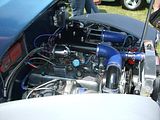I am new here and have no mechanical training other than owning a haynes manual and plenty of trial and error, so be gentle!
I have a 1992 EFI 3.9 Range rover. She's converted to run on LPG via a vapouriser system, not injection. A few months ago I had an issue where one of the hoses leaked and peed out some coolant. I thought it might be due to pressure, but found a small area of wear and tear on the hose (near another jubilee clip, so probably someone caught it with a tool). I topped back up with reverse osmosised water (as filtered as you can get!), got the car home and replaced the pipe. The temperature gauge never got above 1/4 as the weather was quite cool. The engine didn't smell or seem to be burned (a smell I HAVE previously encountered in my first RR, a £300 toy)
I have always had a little white steam from the exhaust (for the last year or so, as long as I've owned it) but in the last month this has increased somewhat.
Well anyway I was on a fairly long journey and the coolant light came on so I stopped, let the engine cool and checked it, sure enough the level had dropped an inch. I topped up and drove a further 200 miles, and the level had dropped another 2 inches in the expansion tank.
I did a compression check cold as I didn't have time to get to it when hot, and all the readings were about 12bar ±.8 bar. Well while this isn't informative as it was cold... I did notice something odd!
The spark plugs in the left bank were a light cream colour indicative of lean running, and those on the right bank were blackened, indicative of rich running.
I run the car on LPG 2/3 of the time, and petrol 1/3, and on hope most of the time. The latter tends to be most expensive indeed.
At no point during these issues has the temp gauge climbed above 1/2. When I first got the car I drove it up a mountain on a warmish day and it got a bit above this and exhibited no issues so I know the gauge works well.
Also, when first started and for the first few minutes, if you let it idle for a minute, and then press the throttle very slightly, the revs drop from 500 to about 200 before it revs. (not always but sometimes).
So I have a few questions:
Does anyone know if this is likely to be a head gasket, cracked head, cracked block or LPG fault? And how to diagnose each
If I put a set of rebuilt heads and new gaskets on it and it is still steaming (block damage) can this damage the new heads? And thus will I lose my money:?:
If when running on petrol it still uses coolant and steams is it still possible the LPG vapouriser coul be leaking coolant into the LPG pipes
Yours Sincerely,
Mosesthemonk






